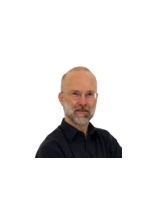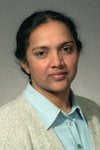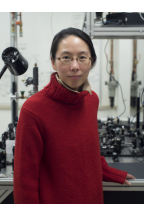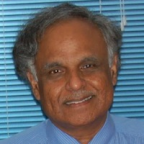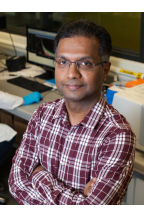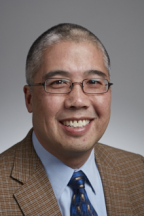Professor Information:
Hany Aziz is a professor in the Department of Electrical and Computer Engineering with a cross-appointment to the Department of Chemical Engineering. He served as the Associate Director of Waterloo’s Nanotechnology Engineering program from 2015-2019. He is also Associate Director of the Giga-to-Nanoelectronics Centre. He previously held the appointment of NSERC- DALSA Research Chair in organic electronics.
Dr. Aziz’s group conducts research in the interdisciplinary area of organic electronics and optoelectronics including both electroluminescent (such as Organic Light-Emitting Devices or OLEDs and quantum dot LEDs ) and light harvesting (such as organic photovoltaics and optical sensing) materials and devices. The research spans a wide range of areas ranging from studying fundamental phenomena in organic semiconductors (such as carrier injection and transport, exciton dynamics, carrier-exciton interactions) to developing novel devices and fabrication technologies for next generation electronics (such as flexible flat panel displays and printable electronics).
Dr. Aziz’s research contributions are widely cited in the organic electronics community, and have resulted in over 150 peer-reviewed publications to date. He has several inventions including the industry’s benchmark long-life and thermally-stable OLED and the contrast enhancing Black Cathode™ Technology. He holds 51 U.S. patents. In 2020 he was awarded a University Research Chair.
-
Organic electronics
-
Optoelectronic materials and devices
-
Charge and energy transfer in amorphous semiconductors
-
Materials for flexible and printable electronics
-
Nanotechnology
-
Additive manufacturing
-
Renewable energy
-
Nano-electronics
-
Organic light emitting devices (OLEDs)
-
Organic photovoltaics
-
Optical sensing\/imaging
Chris Backhouse is a Professor in the Electrical and Computer Engineering department at the University of Waterloo.
His research interests include nano-biological technology based quantum devices, medical diagnostics, miniaturization and microfluidic lab-on-a-chip systems.
Following graduation at the University of British Columbia, Professor Backhouse held academic and industrial fellowships in electrochemistry with the university and in non-invasive medical imaging with CTF Systems. Working together with Applied Biosystems, a life technologies company, he developed large-scale microchips and their fabrication technologies for use in the Human Genome Project. Professor Backhouse also led a research team in developing genetic analysis instrumentation that is now being sold internationally.
Professor Backhouse’s research work was recognized by the Association of Professional Engineers, Geologists, and Geophysicists of Alberta and was awarded the Summit Award for Project Achievement in 2008. His accomplishments were also recognized by Engineers Canada, thus presenting him with the National Award for an Engineering Project of 2009. In addition to his many accomplishments, Professor Backhouse has written numerous articles and journals through IEEE and other various organizations.
-
Quantum devices
-
Biomedical engineering
-
MEMS/MOEMS and CMOS integration
-
Lab on chip
-
Medical diagnostic devices
-
Microfluidic devices
-
Radio astronomy
-
Sensors
-
Microfabrication
-
Remote sensing
-
MEMS/NEMS
-
Nanotechnology
Dayan Ban is a professor in the Department of Electrical and Computer Engineering, Associate Director for the Centre for Intelligent Antenna and Radio Systems, and a researcher at the Waterloo Institute for Nanotechnology. His expertise lies in the conversion of near infra-red light directly to visible light, design and fabrication of high-performance quantum devices and the development of ultra-sensitive surface plasmon sensors.
Dr. Ban successfully improved the efficiency of hybrid organic/inorganic devices by more than one order of magnitude and applied time-domain terahertz spectroscopy to study the device physics of terahertz quantum cascade lasers. Dr. Ban’s research has also accomplished the fabrication of prototype hybrid organic/inorganic devices by direct tandem integration and the study of the effects of interfacial states on device performance. These devices are responsible for the conversion of near-infrared light directly to visible light (green) at room temperature.
Dr. Ban pioneered the development of new methods in scanning probe microscopy to observe, with nanometric spatial resolution, two-dimensional profiles of conductivity and potential inside actively-driven lasers. He also resolved the nanoscopic reason for anomalously high series resistance encountered in ridge waveguide lasers. In addition, Dr. Ban reported the first direct experimental observation of electron overbarrier leakage in operating buried heterostructure multi-quantum-well –lasers. His work has provided the first experimental visualization of the inner workings of operating semiconductor lasers, and has also provided a platform for enabling tools for quantum semiconductor device and nanotechnology research.
- Semiconductor quantum devices, Photonics, THz technology, Nanotechnology, Atomic force microscope, Fiber-optical communication system, Silicon Devices, Terahertz Quantum Cascade Lasers, Biophotonics, Scanning Probe Microscopy, Connectivity and Internet of Things, Nanofabrication, IoT, Devices, Application domains
Shesha H. Jayaram (S’87–M’91–SM’97–F’08) received the B.A.Sc. degree in electrical engineering from Bangalore University, Bangalore, India, the M.A.Sc. degree in high voltage engineering from the Indian Institute of Science, Bangalore, and the Ph.D. degree in electrical engineering from the University of Waterloo, Waterloo, ON, Canada, in 1980, 1983, and 1990, respectively. She has held various academic positions at the University of Waterloo since 1992, where she is currently a Full Professor, the University Research Chair, and the Director of the High Voltage Engineering Laboratory. She is also an Adjunct Professor with the University of Guelph, Guelph, ON, and McMaster University, Hamilton, ON. Prior to joining the University of Waterloo, she served on the faculty with the University of Western Ontario, London, ON, as an Assistant Professor from 1990 to 1992 and as an Adjunct from 1992 to 2003.
Her current research interests include solution-based outputs, high-voltage engineering and insulation diagnostic, high-voltage engineering applied to environment, nanocomposite materials, and pulse power applied to biotechnology.
Dr. Jayaram has been an active member of the IEEE Dielectrics and Electrical Insulation and Industry Applications Societies and the Electrostatic Society of America. She is a Registered Professional Engineer in the Province of Ontario, Canada.
-
Conduction and breakdown mechanisms
-
HV stress
-
Partial discharge
-
Insulation failure
-
High voltage engineering applications
-
Power supplies
-
High voltage testing techniques
-
Pulse power applications
-
Electrostatics problems
-
Energy Systems
-
Hybrid and electric vehicles
-
Energy storage
-
Power systems
-
Renewable energy
-
Nano-materials
-
Non-thermal food processing techniques
-
Non-thermal plasma applications
-
Nano-fabrication techniques
-
Water
Dr. Karim S. Karim is a Professor in Electrical and Computer Engineering at the University of Waterloo. He has raised more than $15M in research grant funding, trained over 40 PhD and MASc students, has co-authored 250+ publications and 50+ patents. He is also a founder and Chief Technology Officer of KA Imaging, a University of Waterloo spinoff that makes innovative X-ray detectors and systems for medical, veterinary, scientific and industrial markets. Dr. Karim has developed novel imaging devices and systems since 1998 and has both supported and founded multiple startups in the past two decades. One of his “color” X-ray innovations is now starting to replace black and white medical X-ray globally while another is used in ultrasonic fingerprint sensors in mobile phones and tablets.
-
Spectral X-ray Imaging
-
Phase Contrast X-ray Imaging
-
Medical Imaging
-
Large area electronics
-
Semiconductor Devices and Fabrication
Na Young Kim is an Associate Professor in the Department of Electrical and Computer Engineering. She has an affiliation with the Institute for Quantum Computing and and Waterloo Institute for Nanotechnology and cross-appointments with the Department of Physics and Astronomy and the Department of Chemistry.
Na Young leads the Quantum Innovation (QuIN) laboratory, which aims to build large-scale quantum processors based on novel materials and advanced technologies. Two kick-off projects are under way: (1) a semiconductor quantum processors project that establishes controllable optical and electrical domains, in which her research team is learning insights of exotic materials and the fundamental nature of symmetries, and (2) a project in which a multi-functional classical and quantum device arrays establishes a planar architecture comprised of nano-scale devices with electrical, optical, thermal and mechanical functionality.
Prior to joining the University of Waterloo in 2016, Na Young worked for Apple Inc. developing small display products. She received a BS in Physics from Seoul National University and pursued her graduate studies exploring mesoscopic transport properties in low-dimensional nanostructures in the Department of Applied Physics at Stanford University. During her postgraduate research, she expanded her scope to the fields of quantum optics and nanophotonics, working on several experimental and theoretical projects in collaboration with graduate students, postdoctoral scholars and collaborators.
-
Large-Scale Solid-State Quantum Computer
-
Quantum Simulator
-
Quantum Information Processing & Communications
-
Quantum Artificial Intelligence
-
Quantum Security
-
Nanotechnology
Peter Levine is an Associate Professor in the Department of Electrical and Computer Engineering at the University of Waterloo. His research group develops complementary metal-oxide-semiconductor (CMOS) integrated circuits (ICs) that translate the chemical world of biology to the digital world. By combining standard CMOS analog/mixed-signal ICs with novel structures, materials, or devices, he and his team are developing advanced CMOS imagers and biosensors for a wide range of life-science and biosensing applications.
-
CMOS analog/mixed-signal integrated circuits (ICs)
-
CMOS electrochemical biosensors
-
CMOS imagers (visible, IR, and X-ray)
Amir Hamed Majedi is a Professor in the Department of Electrical and Computer Engineering, and cross-appointed to the Department of Physics and Astronomy at the University of Waterloo. Professor Majedi leads the Integrated Quantum Optoelectronics Lab (IQOL) within the Waterloo Institute for Nanotechnology.
His main research interests lie within engineering quantum electrodynamics with a focus on superconducting optoelectronics and quantum photonics. His research activities encompass superconducting nanowire single photon detectors, single photon sources based on nanowire quantum dots, superconducting plasmonic detectors and waveguides, superconducting-based quantum dot LEDs for single and entangled photon sources, and graphene photonics.
IQOL pursues theoretical and experimental investigations of quantum and electromagnetic phenomena in superconducting micro-to-nano scale structures to advance optoelectronic, mm-wave/THz and photonic devices and systems. The group aims to develop theoretical foundations, design methodologies, device/system level synthesis, and characterization techniques in order to create superconductive quantum devices for applications that include ultrafast communications and quantum information processing and bio-nanotechnology.
-
Quantum photonics
-
Superconducting optoelectronics
-
Microwave-photonics
-
Superconducting & photonic quantum devices
-
THz photonic devices
-
Systems Electromagnetic band gap structures
-
Nano-electrophotonics
-
Nano-electrodynamics
-
Microwaves & Photonics
-
Nano-electronics
-
Single-Photon Technology
-
Photonics
-
Quantum Information Technology
-
Quantum Electronics
-
Solid-state Quantum Electrodynamics
-
Nanotechnology
Raafat Mansour is a Professor in the Department of Electrical and Computer Engineering at the University of Waterloo. He is a former holder of a Tier 1 Canada Research Chair in Micro-Nano Integrated RF Systems. He held an NSERC Industrial Research Chair (IRC) for two terms (2001-2005) and (2006-2010). Prior to joining the University of Waterloo in January 2000, Dr. Mansour was with COM DEV Cambridge, Ontario from 1986-1999, where he held various technical and management positions in COM DEV’s Corporate R&D Department. Professor Mansour holds 37 US and Canadian patents and has more than 380 refereed publications to his credit. He is a co-author of a 23-chapter book published by Wiley and has contributed 6 chapters of 4 other books.
Since joining the University of Waterloo in 2000, Professor Mansour has graduated 37 PhD and 32 MASc students, and trained 14 Postdoctoral Fellows. His students hold key positions in academia and industry, including 5 holding faculty positions. Professor Mansour founded the Centre for Integrated RF Engineering (CIRFE) at the University of Waterloo. It houses a clean room and a state-of-the-art RF test and characterization laboratory. Professor Mansour acted as a catalyst for ideas inspiring the next generation of Waterloo entrepreneurs to bring their work to market. Out of research carried out in his research Lab at the University of Waterloo, Professor Mansour and his graduate students co-founded two companies: AdHawk Microsystems and Integrated Circuit Scanning Probe Instruments (ICSPI-Corp).
Professor Mansour is a Fellow of IEEE, a Fellow of the Canadian Academy of Engineering (CAE), a Fellow of the Engineering Institute of Canada (EIC). He was the recipient of the 2014 Professional Engineers Ontario (PEO) Engineering Medal for Research and Development and the 2019 IEEE Canada A.G.L. McNaughton Gold Medal Award.
-
Tunable \/ Reconfigurable Microwave and Millimeter-wave circuits and subsystems
-
Filters and Multiplexers
-
RF MEMS Technology
-
RF Phase Change Material (PCM) Technology
-
Microwave and Millimeter-wave Components for 5G Communication Systems
-
Superconductive Microwave and Millimeter-wave Devices
-
Computer-aided Tuning of Microwave Devices
-
Intelligent RF\/Microwave Sub-systems
-
CMOS-MEMS Nano Instrumentations
Guo-Xing Miao is an Associate Professor in the Electrical and Computer Engineering Department and is cross-appointed to the Institute for Quantum Computing at the University of Waterloo. Professor Miao's research interests lie in spintronics, which use precise electron spin manipulation for information processing. His work places a strong emphasis on nanodevices established on newly emerging spin platforms, such as synthetic diamonds and topological insulators, where information can be processed coherently on the quantum level, rather than digitally on the classical level. The interwined transport of electrons, spins and ions in solid-state devices establishes the forefront for developing semiconductor compatible materials platforms ready for chip integration.
- Topologically quantum computing, Tellurides MBE, Spin memory and logic devices, Spintronics, Iontronics, Resistive switching and neuromorphic computing, Nanotechnology
David Nairn is an Associate Professor in the Department of Electrical and Computer Engineering at the University of Waterloo.
His research is mainly in the field of electronic circuits, including analog and mixed signal circuit design, with an emphasis on analog-to-digital converters (ADCs), and digital-to-analog converters (DACs).
- Analog and Mixed Signal Circuit Design, Analog-to-Digital Converters (ADCs), Digital-to-Analog Converters (DACs), Circuit Design & VLSI
Omar Ramahi is an Electrical and Computer Engineering Professor at the University of Waterloo.
Professor Ramahi’s research interests include radiating systems, renewable energy technology, biomedical applications of electromagnetic waves and fields, electromagnetic compatibility and interference, metamaterials and its engineering applications, and material measurements. In addition to his research, he co-founded Applied Electromagnetic Technology, LLC., and Wave Intelligence Inc.
Professor Ramahi has received numerous awards as a result of his extensive research and teaching capabilities. He was recognized for his graduate research work with the 2010 University of Waterloo Award for Excellence in Graduate Supervision. Additionally, Professor Ramahi was awarded the IEEE Electromagnetic Compatibility Society Technical Achievement Award in 2012. Professor Ramahi is an elected IEEE Fellow.
Professor Ramahi has written over 450 journal and conference papers on electromagnetic phenomena and computational techniques. EMI/EMC Computational Modeling Handbook is one of the notable books that Professor Ramahi has co-authored.
- Radiating Systems, Theoretical and Computational Electromagnetics, Electromagnetic Compatibility, Interference and Electronic Packaging, Biomedical Applications of Electromagnetics, Photonics, Material measurements, Antennas, Microwaves & Photonics, Medical imaging, Scanning, Energy harvesting/bio-energy, Renewable energy, Sensors and devices, Wireless communications/networking
Manoj Sachdev is a Professor in the Department of Electrical and Computer Engineering at the University of Waterloo. His research interests include low power and high performance digital circuit design, mixed-signal circuit design, and test and manufacturing issues of integrated circuits. He has contributed to over 180 conference and journal publications, and has written 5 books. He also holds more than 30 granted US patents.
Professor Sachdev, along with his students and colleagues, have received several international research awards. He is a Fellow of the Institute of Electrical and Electronics Engineers (IEEE), and Fellow of the Engineering Institute of Canada. Professor Sachdev serves on the editorial board of the Journal of Electronic Testing: Theory and Applications. He is also a member of program of IEEE Custom Integrated Circuits Conference.
- Digital circuit design for low power, low voltage applications, High performance mixed-signal circuit design, Robust design practices for VLSI, VLSI testing and design, VLSI quality, VLSI reliability, VLSI improvement techniques, Circuits Design & VLSI, Cybersecurity, Application security, Network security
Simarjeet Saini is an Associate Professor in the Department of Electrical and Computer Engineering at the University of Waterloo. He completed his doctorate at the University of Maryland, College Park in 2001 under the guidance of Professor Mario Dagenais. Professor Saini’s Ph.D. thesis was on design and development of a new platform technology for monolithic integration of photonic devices called Passive Active Resonant Coupler (PARC). The resulting technology led to the foundation of a start-up company called Covega Corporation in Jessup, Maryland. Professor Saini worked as the Lead Optoelectronics Device Engineer at Covega, and later, as a Lead Applications Engineer. He led the design and development of Covega’s single angled facet chips, semiconductor optical amplifiers and high power lasers.
In August 2004, Professor Saini co-founded Altanet Communications, a start-up company that focused on ethernet based metro area networks with less than 5 ms restoration time using intelligence in the optical domain.
Professor Saini’s research interests include: optoelectronics components for datacom and telecom, high speed optical networks, tunable mid-IR lasers, nanophotonics chem-bio sensors, and microwave photonics. He holds 5 US patents and has 5 more in various stages of application, of which 3 have already been commercialized.
- Monolithic Integration of photonics devices, Optoelectronics components for datacom and telecom, High speed optical networks, Tunable mid-IR lasers, Nanophotonics Chem-Bio Sensors, Microwave photonics, Antennas, Microwaves & Photonics, Water, Nanotechnology
Chettypalayam (Selva) Selvakumar is a Professor in the Department of Electrical and Computer Engineering at the University of Waterloo.
Professor Selvakumar’s research interests include bipolar and field effect devices modeling and experimental process technologies. His current interests lie in Silicon/Germanium (SiGe) Devices and low temperature and integrable IC technologies. On the modelling side, Professor Selvakumar’s efforts are concentrated on developing insightful analytical models and accurate D.C. and A.C. Device Models for Bipolar and Field Effect Devices over a wide range of temperatures. Efforts in process modeling are currently focussed on dopant diffusion in implantation-formed alloy semiconductors. Research interests on the experimental side are focused on integrable process technologies. Professor Selvakumar is also interested in silicon-on-insulator technologies and buried silicides for high performance IC technologies, sensors and optoelectronics.
-
Bipolar and field effect devices
-
modeling
-
SiGe devices
-
integrable technologies
-
Photodetectors (UV VIS IR)
-
Silicon Devices & Nanotechnology
Siva Sivoththaman is a Professor in the Department of Electrical and Computer Engineering and Associate Dean, Graduate Studies & Postdoctoral Affairs in the Faculty of Engineering.
Professor Sivoththaman received the Doctorate from University of Paris XII - Creteil Val de Marne (France) in 1993. He then worked as a Research Scientist at the Interuniversity Micro Electronic Center - IMEC (Belgium) for six years before moving to Canada in year 2000 to join the Department of Electrical and Computer Engineering at the University of Waterloo. Professor Sivoththaman was a recipient of the Ontario Premier's Research Excellence Award in 2002 and has held two Research Chairs, the NSERC Associate Industrial Research Chair in Radio Frequency Micro Electro Mechanical Systems (2002-2006), and the Ontario Research Chair (ORC) in Renewable Energy Technologies and Health (2010-2015). He is also the Director of the Centre for Advanced Photovoltaic and Display Systems (CAPDS) at Waterloo. Professor Sivoththaman served as the inaugural director of University of Waterloo's Nanotechnology Engineering Program during 2004-2006. He is a Senior Member of the IEEE and currently serves as Chapter Chair for the Electron Devices Society of the IEEE Kitchener-Waterloo section.
-
Solar Photovoltaic Technologies
-
Microelectronic Fabrication
-
Nanotechnology
-
Advanced Photodetectors and Sensors
-
Crystalline Silicon and Thin Film Materials
-
Synthesis of Colloidal Quantum Dots
-
Quantum Dot-enabled Emission Devices
-
Smart Circuits for Solar Photovoltaic Systems
-
Backplane Electronics in Displays
Zbig Wasilewski is an Electrical and Computer Engineering Professor, cross-appointed to the Department of Physics and Astronomy at the University of Waterloo. He is internationally renowned for his groundbreaking contributions to the field of Molecular Beam Epitaxy (MBE), quantum-dot and quantum-well photonic devices, and high-mobility 2D electron gas-based quantum structures and devices.
Professor Wasilewski’s research focuses on MBE and the nanofabrication of III-V semiconductor structures for applications in quantum optics, nano-photonics, nano-electronics, and quantum computing. Under his leadership, the MBE laboratory has achieved the highest operating temperatures worldwide for GaAs/AlGaAs-based THz Quantum Cascade Lasers—some of the most complex man-made quantum structures. Additionally, the laboratory pioneered the In-flush method, the premier technique for creating and fine-tuning MBE-grown InAs/GaAs quantum dot systems for photonic and quantum computing applications.
Professor Wasilewski has co-authored over 500 refereed journal articles and conference proceedings, amassing over 16,000 citations and an h-index of 64, placing him among the most cited researchers in his field. In 2012, he was awarded the lifetime title of Professor of Physics by the President of Poland in recognition of his exceptional research contributions and his role in developing GaN-based optoelectronics in Poland. In 2022, he was elevated to Fellow of the IEEE.
- Sensors and devices, Nano-electronics, Nano-materials, Photonics, Molecular Beam Epitaxy, Nanofabrication, Nanotechnology, Self-assembled nanostructures, Quantum Cascade Lasers and related devices, Advanced Manufacturing
Professor Lan Wei received her B.S. in Microelectronics and Economics from Peking University, Beijing, China in 2005 and M.S. and Ph.D. in Electrical Engineering from Stanford University, Stanford, USA (with Professor H.–S. Philip Wong) in 2007 and 2010, respectively. Before joining University of Waterloo in 2014, she worked at Altera Corporation in San Jose, California, where her responsibilities included foundary technology evaluation, power management and Stratix X FPGA product development with Intel 14nm technology. She also worked as a post-doctoral associate in Microsystems Technology Laboratories, Massachusetts Institute of Technology under Professor Dimitri Antoniadis. Her research focuses on device-circuit interactive design and optimization, cryogenic CMOS electronics for quantum computing, error-resilient computation, and integrated electronic systems using emerging technologies including GaN, RRAM and low-dimensional materials.
Wei has served on the Technical Program Committee of several academic conferences including IEDM (2011-2012, 2021-2022), DATE (2021 - ), ICCAD (2019 - ), VLSI-TSA (2013 - ), GLSVLSI (2017 - ), ISQED (2019 - ) ISLPED (2013), etc, and was listed as one of the key contributors to the Process Integration, Devices, and Structures Chapter (PIDS) of International Technology Roadmap for Semiconductors (ITRS) 2009 Edition. She is the co-developer of the MIT Virtual Source GaN HEMT (MVSG) Compact Model, which is an Industry Standard approved and supported by the Compact Model Coalition for GaN HEMT compact model.
-
Nanoelectronic devices
-
Device-circuit interactive design and optimization
-
Cryogenic CMOS electronics for quantum computing
-
GaN-based devices and circuits
-
Low-dimensional materials based integrated nanoelectronic systems
-
RRAM device, circuit, and integrated system
-
Device-circuit interactive design
-
Error-resilient computing
William S. Wong is a Professor in the Department of Electrical and Computer Engineering, Director of the Giga-to-Nanoelectronics Centre and a researcher at the Waterloo Institute for Nanotechnology at the University of Waterloo.
The Advanced Flexible Electronics Technology (AFET) group, led by Professor Wong, focuses on innovative solutions to enable high-performance and low-cost flexible electronics. The group is investigating heterogeneous integration of silicon-based and Group III-nitride materials and devices for the development of flexible large-area electronics on plastic substrates. This technology is used to create novel mechanically flexible systems for applications in displays, image sensors, and energy generation systems having enhanced functionality. The group uses the capabilities of Giga-to-Nanoelectronics (G2N) Centre to synthesize nanowire materials, process thin-film devices and develop novel nanowire/thin-film hybrid devices through novel ink-jet printing and thin-film layer transfer processes. The goal of the research is to develop innovative processes and materials that will improve system performance and reduce fabrication costs.
Professor Wong is the holder more than 80 U.S. patents and has 110 publications, including 45 invited talks, in the area of electronic materials growth, processing and characterization. He is a member of the IEEE, the Materials Research Society, a committee member of the Electronic Materials Conference, and is on the Editorial Board of IEEE Electron Device Letters.
-
Large-area systems
-
Flexible electronics
-
Printed electronics
-
Heterogeneous Integration
-
Nano- and Microfabrication
Professor Youngki Yoon is an Associate Professor in the Department of Electrical and Computer Engineering at the University of Waterloo. His research group focuses on understanding physics of non-equilibrium phenomena in nanosystems with relevance to device applications by means of modeling and simulations. Building on rigorous fundamental understanding, he has developed his own quantum transport simulator using Non-Equilibrium Green’s Function (NEGF) method. Atomistic simulations may enable predictive analysis of nanoscale devices for which direct experimental investigation can often be extremely challenging and prohibitively expensive.
He received his Ph.D. in Electrical and Computer Engineering from the University of Florida (Gainesville, FL) in 2008, where his research mainly focused on ballistic transport in carbon nanotube devices. Then he worked as a postdoctoral research at the University of California, Berkeley where he has done pioneering work in the field of non-equilibrium quantum transport, including the first demonstration of dissipative simulation using the NEGF formalism for the realistic size of devices (>200 nm) and the first-ever trial that included both phonon and roughness scattering for graphene nanoribbon transistors.
-
Nanoscale transistors and sensors
-
Computer simulations for emerging devices
-
Engineering tool development for analysis and optimization
General fields of application of the research programs include:
-
Organic optoelectronics
-
Photonics
-
Photovoltaic devices
-
Semiconductor quantum devices
-
Nanoelectronics
-
Micro- and nano-fabrication
-
Microfluidics
-
Nano-materials
-
Micro-electromechanical system (MEMS)

